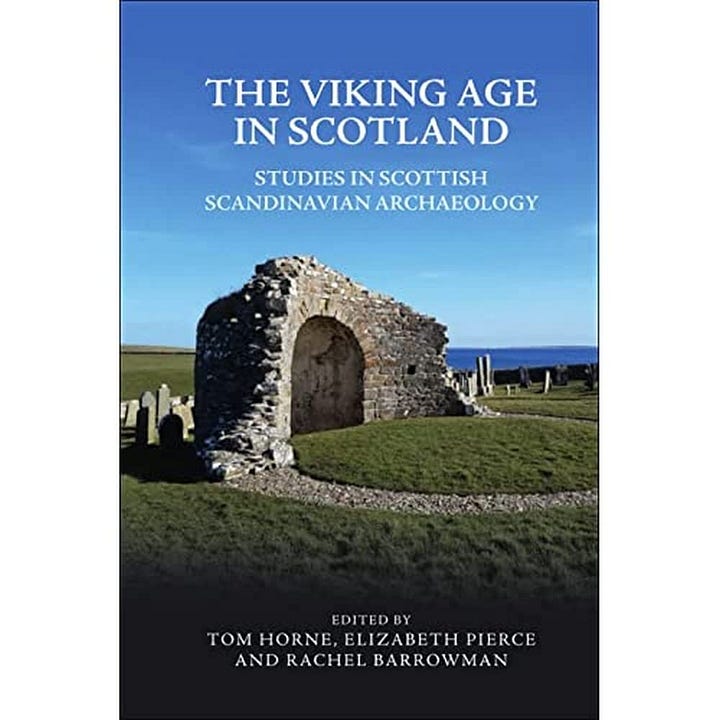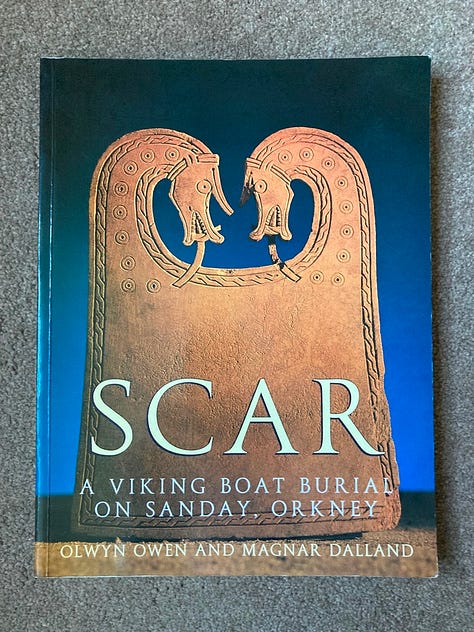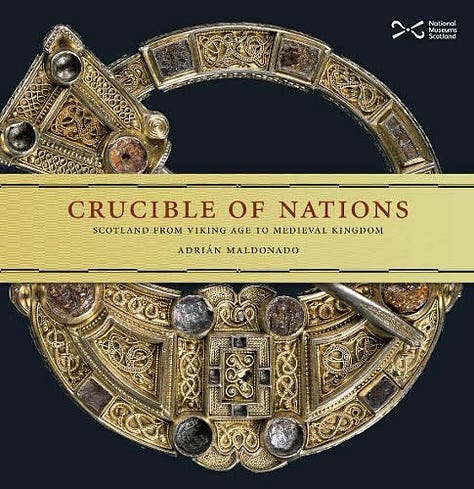On Scottish Books: Dr. Tom Horne
Notable writers and readers share five of their favorite Scottish titles.
For Volume 5 of ‘On Scottish Books’, we are joined by Tom Horne. Tom has a Ph.D. in Viking trade networks and shares a few of his favorite Viking books with us. Take it away Tom!
The most interesting thing I've ever heard was that silver coins from Samarqand were found in a Viking hoard buried on the beach underneath Storr Rock on the island of Skye. Decades later, I still have that sense of wonder, one that has fuelled the devotion of a large part of my life to answering the questions as to how and why these beautiful and outlandishly exotic dirhams travelled to Scotland over such fabulously long distances.
A doctorate, monograph and a co-edited book later, I still think back to that beach where I searched for fossils with my family in the summer of 1995 and try to picture the people who hid the hoard over a thousand years before. Fortunately, my thoughts are informed by some brilliant writing on the Viking Age in Scotland by forebears and colleagues, a selection of which I will share with you now.
1) Vikings in Scotland: An Archaeological Survey (James Graham-Campbell and Colleen Batey) and 2) The Viking Age in Scotland: Studies in Scottish Scandinavian Archaeology (Eds. Tom Horne, Elizabeth Pierce, Rachel Barrowman)


We conceived of The Viking Age in Scotland (2022) as a tribute and continuator to Graham-Campbell and Batey’s magisterial Vikings in Scotland (1998), being inspired by its unsurpassed brilliance and continuing relevance to provide a series of expert updates on the vast and mightily impressive array of topics covered by James and Colleen. Vikings in Scotland (ViS) covered it all, from the history and poetry to the archaeology of graves and domestic life, via farming, fishing, fighting and the silver economies revealed by dirhams, whether one Skye, Orkney, or on a different beach, this time on the Ayrshire coast.
It says everything about their achievement that myself, Elizabeth and Rachel had to gather over two dozen of the best Viking academics to cover the scope of ViS for The Viking Age in Scotland (TVAS). Indeed, as Colleen and James noted in the Afterword of TVAS, this reflects the welcomed increased specialization of studies into Viking Scotland, bringing increasingly nuanced and sophisticated scientific analysis and greatly enlarged datasets to bear on the questions of the origins, practices and movements of the people, animals and things, both precious and quotidian, in the Viking and Late Norse periods in the regions that make up today’s Scotland.
3) Scandinavian Scotland (Barbara Crawford) and Scandinavian Scotland – Twenty Years After (Ed. Alex Woolf)
Our inspiration for a multi-authored academic volume to celebrate the passing of two decades since the publication of a seminal study of Viking-Age Scotland was the 2009 book, Scandinavian Scotland – Twenty Years After, a publication that was also a festschrift for Barbara Crawford, author of 1987’s Scandinavian Scotland.
I recommend reading both, in conjunction with the books listed previously, as their focus on the historical and place-name evidence (although note that both make extensive and brilliant use of the archaeology) is the perfect complement to the archaeological bent of Vikings in Scotland and The Viking Age in Scotland.
4) Scar: A Viking Boat Burial on Sanday, Orkney (Olwyn Owen and Magnar Dalland), The Galloway Hoard: Viking-age Treasure (Martin Goldberg and Mary Davis) and Crucible of Nations (Adrián Maldonado)



The 1991 storm that exposed the Viking boat burial of three individuals and their grave goods on Sanday, Orkney, not only demonstrated the exceptional value of rescue archaeology and rescue archaeologists, but also, in my opinion, introduced us to the future of archaeological report writing, thanks to Owen and Dalland's outstanding 2001 publication, being particularly memorable for its superb use of illustration and use of multiple expert authors within a book clearly designed to be as accessible as it was academically robust. For two excellent reviews that jogged my memory, see Kristján Ahronson in The Scottish Historical Review, 81:2, 258, and Colleen Batey in the Archaeological Journal, 157:1, 486-486.
Potentially buried around the same time as Scar, the Galloway Hoard (deposited c. AD 900) has been similarly fortunate in terms of the publications emanating from its discovery. As I write in February of 2025, the main book to date is Martin Goldberg and Mary Davis’ phenomenal The Galloway Hoard: Viking-age Treasure (2021). Affordable and accessible, with particularly exceptional schematic illustrations of a highly-complex (multiple) deposition, I have grouped this with the Scar publication for the simple reason that they reminded me of each other in all the best ways. If you want to see the best of Scottish Scandinavian archaeology, in terms of the finds themselves and the outreach and interpretation that can be achieved in their publication, then I urge you to read these books.
Following on from Goldberg & Davis, I would have added Galloway Hoard Researcher Adrián Maldonado's equally brilliant Crucible of Nations: Scotland from Viking age to Medieval kingdom, but you'd be far better reading the far more eloquent Fiona Campbell-Howes on it and watching my Galloway Hoard podcast with Adrián:
5) Strathclyde and the Anglo-Saxons in the Viking Age (Tim Clarkson)
You may or may not know much about the Clyde Britons, but the finds made at their caput at Alt Clut (Dumbarton Rock) and at their 1,500-year-old Christian centre and graveyard at Govan Old, now home of the Govan Stones collection of Viking-Age carved stone monuments, can be added to the limited references in the historical record to more than hint at the enormous importance of this people in the trajectory of early medieval northern Britain.
The archaeological research led by Leslie and Elizabeth Alcock and Stephen Driscoll over the last decades has begun to reveal a true lost world caught in and formed by the maelstrom of Northumbrian, Pictish, Viking and Scottish force projection in the lands that now form central Scotland.
For those who wish an introduction to the complex story that’s being unearthed - and we note the continuing excavations by the University of Glasgow’s Driscoll, Clyde Archaeology and community volunteers - a guide is at hand in the form of Tim Clarkson’s Strathclyde and the Anglo-Saxons, a detailed and intricate yet fully accessible and enjoyable book that helps contextualise an opaque period and allows us to further appreciate new finds at Govan Old, such as 2023’s discovery of the ‘Govan Warrior’ carved stone.
If you want to know more about the Govan Stones, my colleagues Bex and Annemarie have established the Govan Early Medieval Podcast, which you can find via most providers, including Spotify:
Bio
Brought up in Glasgow, Tom read Ancient and Modern History at Balliol College, University of Oxford, before working as a researcher for BBC history documentaries. His introduction to archaeological excavations began when he volunteered for the Tiber Valley Project and the Sangro Valley Project in Italy, and Tom has gone on to dig across Britain and in Ukraine. He has an MLitt in Medieval Archaeology and a Ph.D. in Viking trade networks, and has written the monograph, A Viking Market Kingdom in Ireland and Britain, as well as co-edited The Viking Age in Scotland among other academic writing. A Communications and Press Relations professional, Tom also volunteers as a guide and Comms Manager at the Govan Stones in Glasgow, for which he also produces the Govan Early Medieval Podcast.
For more from Tom:
Website | Bluesky | Instagram | LinkedIn
Thank you so much Tom! And thank you all for reading. Stay tuned for future installments of ‘On Scottish Books’!
You might also enjoy:
My Scottish Bookshop Directory and Scottish Wanderlust Book Club :)
Lilly








